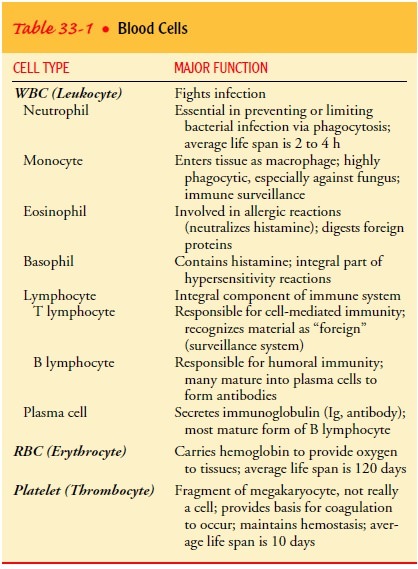Chapter: Medical Surgical Nursing: Assessment and Management of Patients With Hematologic Disorders
Blood - Anatomic and Physiologic Overview
BLOOD
The
cellular component of blood consists of three primary cell types (Table 33-1): RBCs (red blood cells or erythrocytes),
WBCs (white blood cells or leukocytes),
and platelets (thrombo-cytes). These cellular components of blood normally make
up40% to 45% of the blood volume. Because most blood cells have a short life
span, the need for the body to replenish its supply of cells is continuous;
this process is termed hematopoiesis.
The primary site for hematopoiesis is the bone marrow. During em-bryonic
development and in other conditions, the liver and spleen may also be involved.

Under
normal conditions, the adult bone marrow produces about 175 billion RBCs, 70
billion neutrophils (mature form of
a WBC), and 175 billion platelets each day. When the body needs more blood
cells, as in infection (when WBCs are needed to fight the invading pathogen) or
in bleeding (when more RBCs are re-quired), the marrow increases its production
of the cells required. Thus, under normal conditions, the marrow responds to
increased demand and releases adequate numbers of cells into the circulation.
The
volume of blood in humans is approximately 7% to 10% of the normal body weight
and amounts to 5 to 6 L. Circulating through the vascular system and serving as
a link between body or-gans, the blood carries oxygen absorbed from the lungs
and nutrients absorbed from the gastrointestinal tract to the body cells for
cellular metabolism. Blood also carries waste products produced by cellular
metabolism to the lungs, skin, liver, and kidneys, where they are transformed
and eliminated from the body. Blood also carries hormones, antibodies, and
other substances to their sites of action or use.
To function, blood must remain in its normally fluid state. Because blood is fluid, the danger always exists that trauma can lead to loss of blood from the vascular system. To prevent this, an intricate clotting mechanism is activated when necessary to seal any leak in the blood vessels. Excessive clotting is equally dan-gerous, because it can obstruct blood flow to vital tissues. To pre-vent this, the body has a fibrinolytic mechanism that eventually dissolves clots (thrombi) formed within blood vessels. The bal-ance between these two systems, clot (thrombus) formation and clot (thrombus) dissolution or fibrinolysis, is called hemostasis.
Related Topics